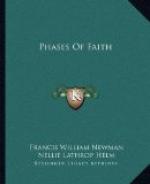Here, however, was a new point started. Does the question of the derivation of the human race from two parents belong to things cognizable by the human intellect, or to things about which we must learn submissively? Plainly to the former. It would be monstrous to deny that such inquiries legitimately belong to physiology, or to proscribe a free study of this science. If so, there was an a priori possibility, that what is in the strictest sense called “religious doctrine” might come into direct collision, not merely with my ill-trained conscience, but with legitimate science; and that this would call on me to ask: “Which of the two certainties is stronger? that the religious parts of the Scripture are infallible, or that the science is trustworthy?” and I then first saw, that while science had (within however limited a range of thought) demonstration or severe verifications, it was impossible to pretend to anything so cogent in favour of the infallibility of any or some part of the Scriptures; a doctrine which I was accustomed to believe, and felt to be a legitimate presumption; yet one of which it grew harder and harder to assign any proof, the more closely I analyzed it. Nevertheless, I still held it fast, and resolved not to let it go until I was forced.
A fresh strain fell on the Scriptural infallibility, in contemplating the origin of Death. Geologists assured us, that death went on in the animal creation many ages before the existence of man. The rocks formed of the shells of animals testify that death is a phenomenon thousands of thousand years old: to refer the death of animals to the sin of Adam and Eve is evidently impossible. Yet, if not, the analogies of the human to the brute form make it scarcely credible that man’s body can ever have been intended for immortality. Nay, when we consider the conditions of birth and growth to which it is subject, the wear and tear essential to life, the new generations intended to succeed and supplant the old,—so soon as the question is proposed as one of physiology, the reply is inevitable that death is no accident introduced by the perverse will of our first parents, nor any way connected with man’s sinfulness; but is purely a result of the conditions of animal life. On the contrary, St. Paul rests most important conclusions on the fact, that one man Adam by personal sin brought death upon all his posterity. If this was a fundamental error, religious doctrine also is shaken.




